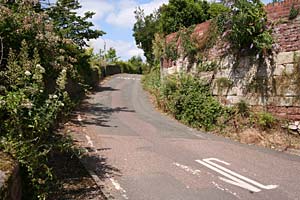
Glasshouse Lane
Page updated 11 September 2008
This lane was named in 1947 after the glass factory that had existed by the river from 1681. Up until that date, bottles were imported by sea from Bristol and London. Bottle seals from around Topsham have been found bearing the name Francis Day, who ran the glass cone in the middle of the eighteenth century. The glass cone measured 94 ft high by 60 ft in diameter, and along with a pound house, a barn, stable, two small dwellings and some outhouses, was quite a large concern. Early bottles from the factory were squat and baggy, but by the 1750's they had acquired the shape closer to that of a modern sherry bottle. See Glass House Factory for a longer history.
For one brief moment in time, the glass house was used to house prisoners of war In 1746, Joseph Crew a collector of customs, was requested by the Sick and Hurt Board of the Admiralty to prepare the buildings of the glass house to accommodate French prisoners of war. He was paid £15 per annum for as many as 1,100 prisoners, who were held in various places around Exeter, as well as at the glass house. It was intended to hold them all on the premises, but preparations were not complete. There is evidence that a Captain Reynolds sublet the glass house to Crew.
The Sugar House
Sometime after 1684 a sugar refinery was established in the same area as the glasshouse. The refinery was owned by Samuel Buttall who had a sugar plantation in South Carolina. opened the factory and later took his sons, Benjamin and John into partnership. His brother, Charles Buttall also supplied the factory from his slave plantation in Barbados. Samuel Buttall died in 1723 and his son-in-law, Sir Nathaniel Hodges took a half share in the business during 1725. The sugar house prospered for a few years, but by 1743 it was but a memory, having "...lain void for want of a tenant". In 1744, Sir Nathaniel's wife, Lady Hodges sold the works as instructed by his will. It was at the end of the 18th century that the elegant Retreat House was built on the site.
After the sugar and glass houses had closed, the landing stage at Glass House was used to land culm, limestone slates and timber. In 1792, Robert Davy established at Glass House and Gulpit, near Countess Wear, two shipbuilding yards, where, between 1792 and 1812 thirteen vessels were built. In 1830, Davy stated that he had built the 600 ton, Batavia.
Tobacco
A letter in the Flying Post in February 1829 mentions a Mr Richard Chown who was credited with planting an experimental field of tobacco at the bottom of Glasshouse Lane. Chown had lived in America for a number of years, and had concluded that the climate, and soil of the site sloping down to the Exe could produce a good crop.
Glasshouse Lane is situated in Lower Wear, part of Countess Wear, and runs through a large council built estate, between the Topsham Road and the river.
Source: The French Prisoner-of-War Hospital at Glasshouse by S Bhanji in the Transactions of the Devonshire Association, The Ports of the Exe Estuary by E A G Clark.
 One of the last traditional cottages
in Glasshouse Lane.
One of the last traditional cottages
in Glasshouse Lane.
 The wall to the right was the
boundary of the glasshouse. An inspection of the wall reveals that
part is made up of vitrified fire-brick, that was used to build
the cone.
The wall to the right was the
boundary of the glasshouse. An inspection of the wall reveals that
part is made up of vitrified fire-brick, that was used to build
the cone.
│ Top of Page │